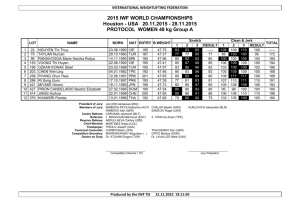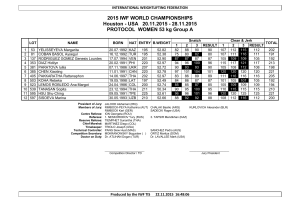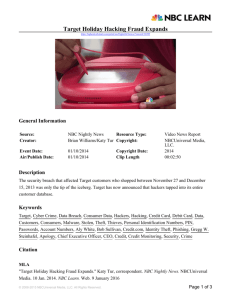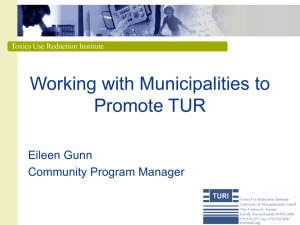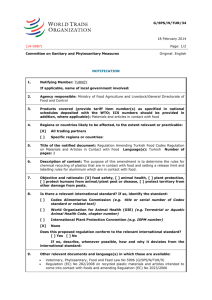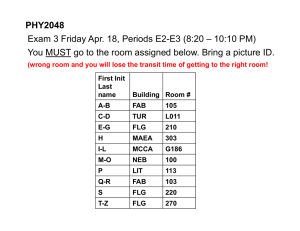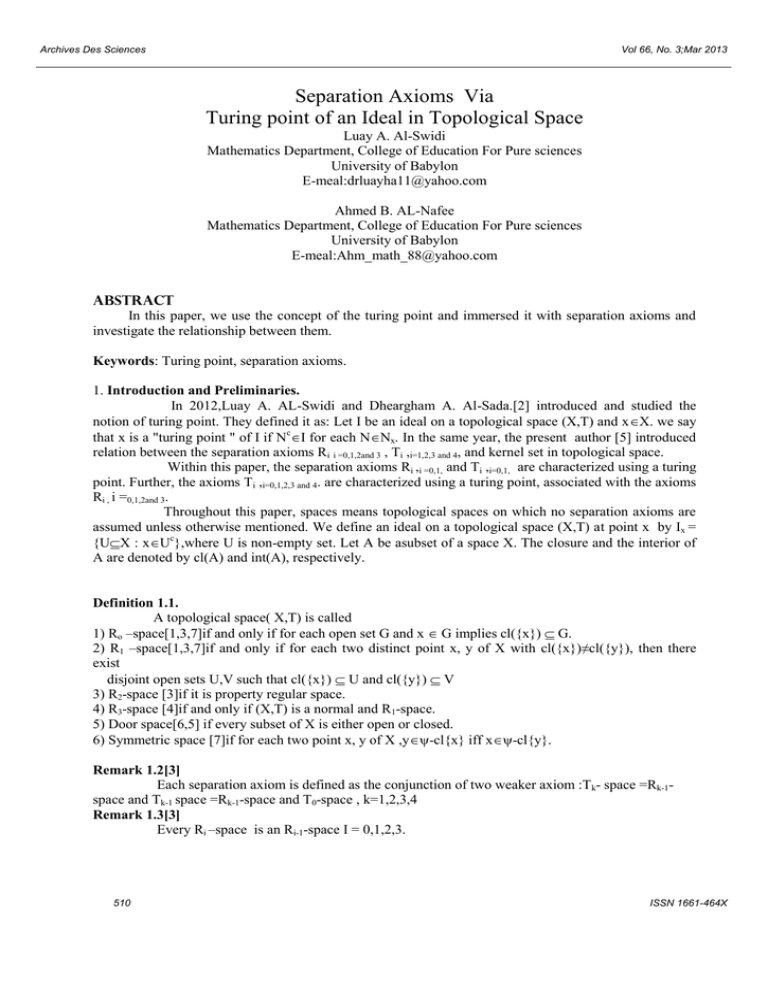
Archives Des Sciences
Vol 66, No. 3;Mar 2013
Separation Axioms Via
Turing point of an Ideal in Topological Space
Luay A. Al-Swidi
Mathematics Department, College of Education For Pure sciences
University of Babylon
E-meal:drluayha11@yahoo.com
Ahmed B. AL-Nafee
Mathematics Department, College of Education For Pure sciences
University of Babylon
E-meal:Ahm_math_88@yahoo.com
Abstract
In this paper, we use the concept of the turing point and immersed it with separation axioms and
investigate the relationship between them.
Keywords: Turing point, separation axioms.
1. Introduction and Preliminaries.
In 2012,Luay A. AL-Swidi and Dheargham A. Al-Sada.[2] introduced and studied the
notion of turing point. They defined it as: Let I be an ideal on a topological space (X,T) and xX. we say
that x is a "turing point " of I if NcI for each NNx. In the same year, the present author [5] introduced
relation between the separation axioms Ri i =0,1,2and 3 , Ti ,i=1,2,3 and 4, and kernel set in topological space.
Within this paper, the separation axioms Ri ,i =0,1, and Ti ,i=0,1, are characterized using a turing
point. Further, the axioms Ti ,i=0,1,2,3 and 4. are characterized using a turing point, associated with the axioms
Ri , i =0,1,2and 3.
Throughout this paper, spaces means topological spaces on which no separation axioms are
assumed unless otherwise mentioned. We define an ideal on a topological space (X,T) at point x by Ix =
{UX : xUc},where U is non-empty set. Let A be asubset of a space X. The closure and the interior of
A are denoted by cl(A) and int(A), respectively.
Definition 1.1.
A topological space( X,T) is called
1) Ro –space[1,3,7]if and only if for each open set G and x G implies cl({x}) G.
2) R1 –space[1,3,7]if and only if for each two distinct point x, y of X with cl({x})≠cl({y}), then there
exist
disjoint open sets U,V such that cl({x}) U and cl({y}) V
3) R2-space [3]if it is property regular space.
4) R3-space [4]if and only if (X,T) is a normal and R1-space.
5) Door space[6,5] if every subset of X is either open or closed.
6) Symmetric space [7]if for each two point x, y of X ,y-cl{x} iff x-cl{y}.
Remark 1.2[3]
Each separation axiom is defined as the conjunction of two weaker axiom :T k- space =Rk-1space and Tk-1 space =Rk-1-space and T0-space , k=1,2,3,4
Remark 1.3[3]
Every Ri –space is an Ri-1-space I = 0,1,2,3.
510
ISSN 1661-464X
Archives Des Sciences
Vol 66, No. 3;Mar 2013
Theorem 1.4[7]
A topological space (X,T) is - Ro –space if and only if for any two points x, y of X .(y cl{x} iff x-cl{y}).
Theorem 1.5[6]
Every compact Hausdorf space is a T3-space (and consequently regular ).
Theorem 1.6[6]
Every compact Hausdorf space is a normal space (T3-space).
2.Ti and Ri -Spaces,i =0,1
Lemma 2.1
Let (X,T) be a topological space , for any pair of distinct points x and y of X. Then {y} is
closed set if and only if x is not turing point of Iy.
Proof.
Let x,y∈ X such that x≠y. Assume that {y} is closed set in X ,so that {y}cl({y}). But xy ,
we get that xcl({y}). Therefore ,there exists an open set U such that, x ∈ U, U{y} .So that x ∈ U,
UcIy ,because if UcIy, then y{x}c =U ,that mean U{y} ,this a contraction. Hence x is not turing
point of Iy.
Conversely
Let x,y∈ X such that x≠y . Since x is not turing point of Iy then, there exists an open set U
such that, x ∈ U, UcIy, so yU .Thus x ∈ U, U {y} implies xcl({y}).Hence {y} cl({y}) .Thus
{y} is closed set in X .
Theorem 2.2
Let (X,T) be a topological space ,then the following properties are equivalent:
a) (X,T) is a T0 – space
b) for any pair of distinct points x and y of X, x Tur{y} or y Tur{x}.
c) for any pair of distinct points x and y of X, cl({x})≠cl({y}).
proof
ab. Let x, y X with x ≠ y . Assume that x Tur{x} or y Tur{x}. By assumption, there
exists an open set U such that, x ∈ U, UcIy,so yU or there exist an open set V such that, y ∈ V,
VcIx,so xV and we have , x ∈ U, yU or y ∈ V, xV .Thus (X,T) is T0 – space .
ba. Let x,y∈ X such that x≠y and (X,T) is T0 – space, then there exists an open set U such
that, x ∈ U y U or there exist an open set V such that y ∈ V, xV and so x ∈ U, UcIy or y ∈ V, Vc
Ix .Thus x is not turing point of Iy or y is not turing point of Ix.Thus x Tur{y} or y Tur{x}.
bc. Let any pair of distinct points x and y of X, x Tur{y} or y Tur{x}. Then by lemma
2.1,then cl({x})={x} or cl({y})={y}.That means x cl({x}) and y cl({x}) or y cl({x}) and xcl({y}).
Thus we have xcl({x}) but x cl({y}).Hence cl({x})≠cl({y}).
ca. Let any pair of distinct points x and y of X, cl({x})≠cl({y}).Then there exists at least one
point z X such that z cl({x}) but z cl({y}). We claim that x cl({y}). If x cl({y}) then {x}
cl({y}) implies cl({x}) Cl({y}). So, z cl({y}), which is a contradiction. Hence, x cl({y}). Now, x
cl({y}) implies x X – cl({y}), which is an open set in X containing x but not y. Hence X is a T o
space.
Theorem 2.3
If a topological space (X,T) is a Ro- space. Then for any pair of distinct points x and y of X, y
is not turing point of Ix . .
Proof.
511
ISSN 1661-464X
Archives Des Sciences
Vol 66, No. 3;Mar 2013
Assume that (X,T) is an Ro- space, and let x,y∈ X such that x≠y . By assumption ,then cl({x})
V , for each open set V containing x, implies x(cl({x}))c and so cl({x}) Ix ,hence by definition of
turing point we get that y is not turing point of Ix.
Remark 2.4
The converse of theorem 2.6,need not be true as seen from the following example .
Example:2.5
Let X ={x,y} and T={,{y},X} then y is not turing point of Ix={,{y}} ,but X is not a Rospace,.
Remark 2.6
A topological space(X,T) is a symmetric if and only if it is an R0 space.
Proof
By definition, theorem 1.4 [directly] .
Theorem 2.7
Let (X,T) be a topological space ,then the following properties are equivalent:
a) (X,T) is a T1 – space
b) for each x ∈ X .Then {x}=Tur{x}
c) for any pair of distinct points x and y of X, x Tur{y} and y Tur{x}.
d) for any pair of distinct points x and y of X, {x}and {y} are closed sets in X
e) for any pair of distinct points x and y of X, Tur{x} Tur{y} =
f) for any pair of distinct points x and y of X , (X,T) is symmetric space, with x Tur{y} or y
Tur{x}.
Proof.
ab. Assume that (X,T) is a T1 – space, let x X .We will prove that {x} = Tur{x}. It is clear
that {x} Tur{x} .Let y X be such that x≠y. By assumption, there exist an open set V such that, y ∈V
and xV so Vc Ix , that is , y is not turing point of Ix . and so ,y Tur{x} . Thus Tur{x} {x} .
Therefore {x} = Tur{x}.
ba. Assume that {x} = Tur{x}, for each x ∈ X. Let (X,T) be not T1 – space and let x,y∈ X
such that x≠y .Then for each open set V containing x, it contains y,so we get that y is not turing point of
Ix, thus ,Tur{x} contains y ,it is follows that, Tur{x}≠{x} ,this is contraction with assumption.Thus (X,T)
is a T1 – space.
bc. Let x,y∈ X such that x≠y . since {x} = Tur{x}, for each x ∈ X. So that x Tur{y} and
y Tur{x}.
cd. Let any pair of distinct points x and y of X, x Tur{y} and y Tur{x}. Then by lemma
2.1,then {x} and{y} are closed subsets of X.
de. Let any pair of distinct points x and y of X. By assumption , then {x} and {y} are closed
sets and as such {x}c and {y}c are open sets. Thus y {x}c but x {x}c and x {y}c but y {y}c .
Therefore x Tur{x} but y Tur{y}.Thus Tur{x} Tur{y} =
ea. Let x≠y , for each x,yX and Tur{x} Tur{y} = , such that (X,T) is not T1 – space.
Then for each open set V containing x, it contains y, so x, y V ,implies VcIx and Vc Iy ,so we get that
x Tur{x} and x Tur{y}.So that Tur{x} Tur{y} ≠ .This is a contraction . Hence (X,T) is a T1 – space
.
af. Assume that (X,T) is a T1 – space. Then by remark 2.6, it is a Ro- space and T0 –space .
Hence (X,T) is symmetric space and y Tur{x} and x Tur{y} [Theorem 2.2 and remark 2.6].
512
ISSN 1661-464X
Archives Des Sciences
Vol 66, No. 3;Mar 2013
fa. Let x≠y , for each x,yX and (X,T) is symmetric space, with x Tur{y} or y Tur{x}
.Then by remark 2.6, it is a Ro- space . Also it is a To–space [since x Tur{y} or y Tur{x}] . Thus it is a
T1–space[By remark 1.2].
Corollary 2.8
A topological space(X,T) is a T1 – space if and only if ,for each x ∈ X. Then cl({x}) = Tur{x}.
Proof
By theorem 2.7 [directly] .
Theorem 2.9
A topological space(X,T) is R1 – space if and only if ,for each x,y∈ X such that x≠y with
cl({x})≠cl({y}),then ,there exist disjoint open sets U,V such that cl(Tur{x})U and cl(Tur{y})V.
Proof .
Assume that x≠y with cl([x})≠cl({y}) and(X,T)is an R1–space for each x,y∈ X. By
assumption,then there exist disjoint open sets U,V such that cl({x}) U and cl({y}) V . Also (X,T) is a
T1
–
space[Remark 1.2 ] and So by corollary2.11,then cl({x})=Tur{x} and cl({y})=Tur{x}implies
cl(Tur{x})=cl(cl({x}))=cl({x})U,and=cl(Tur{y})=cl(cl({y}))=cl({y})V.
Conversely
Assume that x≠y with cl({x})≠cl({y}) ,for each x,y∈ X, then there exist disjoint open sets U,V
such that cl(Tur{x})U and cl(Tur{y})V.Since,{x}Tur{x}and{y}Tur{y}.Then,cl({x})cl(Tur{x})=
cl(Tur{x}) U andcl({y})cl(Tur{y} V. Therefore (X,T) is R1 – space.
3.Ti ,i=1,2,3 and 4. associated with the axioms Ri , i =0,1,2and 3
Theorem 3.1
For an R1- space (X,T) the following properties are equivalent:
a) (X,T) is a T2- space
b) for each x ∈ X , {x} = Tur{x}
c) for x, y X with x ≠ y, Tur{x}Tur{y}=
d) for x,y X with xy , xTur{y} and yTur{x}.
Proof .
ab. Let x ∈ X .Since (X,T) is a T2-space ,then it is a T1-space. Therefore ,by theorem 2.7, part
'b' , {x} =Tur{x} for each x ∈ X.
ba. Assume that {x}=Tur{x}, for each x ∈X. Then (X,T)is a T1- space[Theorem 2.7, part
'b'].But (X,T) is an R1-space, then (X,T) is a T2-space[Remark 1.2 ].
ac. Since (X,T) be a T2-space,then it is aT1-space,and so Tur{x} Tur{y}= [Theorem 2.7,
part'e'], for any pair of distinct points x and y of X.
ca. Let x and y be two distinct points in X. By assumption,(X,T) is a T1-space [Theorem 2.7 part
'e']. But (X,T) is an R1-space, implies (X,T) is a T2-space [Remark 1.2 ].
513
ISSN 1661-464X
Archives Des Sciences
Vol 66, No. 3;Mar 2013
cd. Let x and y be two distinct points in X. By assumption ,(X,T) is a T1-space[Theorem 2.7
part 'e'].Therefore by theorem2.7 part 'c', then xTur{y} and yTur{x}.
da. Let x and y be two distinct points in X .By assumption, then (X,T) is a T1-space [By
theorem2.7 part'c'].But (X,T) is an R1-space .Hence (X,T) is a T2-space [Remark 1.2 ].
Remark 3.2
Observe that every T2 –space is an T1-space and every T1 –space is an T0-space the converse,
need not be true. But it is true generally, if (X,T) is an R1-space as seen from the following theorem.
Theorem 3.3
For an R1- space (X,T) the following properties are equivalent:
a) (X,T) is a T2- space
b) for each x,y∈ X such that x≠y, either xTur{y} or yTur{x}.
proof.
a b. Let x and y be two distinct points in X. Since (X,T) be a T 2- space ,then (X,T) be a T0space by theorem2.2 part 'b' ,either xTur{y}or yTur{x}.
b a.
Let x and y be two distinct points in X, where x Tur{y} or y Tur{x}, this impels that ( X,T)
is a T0-space[By theorem2.2].But (X,T) is an R1-space .Hence (X,T) is a T2-space. [Remark 1.2 ].
Remark 3.4
Observe that every T3 –space is an T2-space ,the converse, need not be true. But it is true
generally, if (X,T) is an R2-space as seen from the following corollary.
Corollary 3.5
For an R2- space (X,T) the following properties are equivalent:
a) (X,T) is a T3- space
b)
for x X ,{x}Tur{x}.
c) for x, y X with x ≠ y, Tur{x}Tur{y}=
d) or x,y X with xy , xTur{y} and yTur{x}.
proof
By remark 1.3 , remark1.2 and theorem3.2.
Theorem 3.6
For an R2- space (X,T) the following properties are equivalent:
(a)
(X,T) is a T3- space
(b)
for each x,y∈ X such that x≠y, either xTur{y}or yTur{x}.
proof
514
ISSN 1661-464X
Archives Des Sciences
Vol 66, No. 3;Mar 2013
a b. Let x and y be two distinct points in X. Since (X,T) be a T 3- space ,then (X,T) be a T0space by theorem2.2 part 'b' ,either xTur{y}or yTur{x}.
b a. Let x and y be two distinct points in X x Tur{y} or y Tur{x}, this impels that ( X,T)
is a T0-space[By theorem2.2].But (X,T) is an R2-space .Hence (X,T) is a T3-space. [Remark 1.2 ].
Theorem 3.7
For a compact R1-space(X,T) the following properties are equivalent:
a) (X,T) is a T3- space
b)
for x,y X with xy , xTur{y} and yTur{x}.
c) for x, y X with x ≠ y, Tur{x}Tur{y}=
d) for x X ,{x}Tur{x}.
proof
ab. Let x and y be two distinct points in X. By assumption ,then (X,T) is a T1- space , and
so, for each x,y ∈ X such that x≠y, xTur{y}and yTur{x}[Theorem2.7 part 'c'].
ba. Let x and y be two distinct points in X .By assumption, then (X,T) is a T 1-space[By
theorem2.7part 'c']. But (X,T) is R1-space. Hence (X,T) is T2- space [Remark 1.2 ].Which implies that
(X,T) is a compact T2- space. So that (X,T) is a T3- space [Theorem 1.5].
bc. Let x,y∈ X such that x≠y, xTur{y}and yTur{x},and so by theorem2.7part 'c', then
(X,T) is a T1-space,and so for each x,y∈ X such that x≠y, Tur{x}Tur{y}=[Theorem2.7 part 'e'].
cd. Let x X. By assumption, then (X,T) is a T1- space [ by theorem2.7 part 'e'], and so for
each x ∈ X ,then {x} = Tur{x} [theorem2.7 part 'b'].
da. Let x,y∈ X such that x≠y. By assumption, then (X,T) is a T1- space [By theorem2.7 part
'b']. But (X,T) is a compact R1-space and so (X,T) is a compact T2- space [Remark 1.2 ] . Hence (X,T) is
a T3- space [ by theorem 1.5].
Remark 3.8
Observe that every T4 –space is an T3-space,the converse, need not be true. But it is true
generally, if (X,T) is a compact R1-space as seen from the following corollary.
Corollary 3.9
For a compact R1- space (X,T) the following properties are equivalent:
a)
(X,T) is a T4- space
b)
for x,y X with xy , xTur{y} and yTur{x}.
c) for x, y X with x ≠ y, Tur{x}Tur{y}=
d) for x X ,{x}Tur{x}.
proof
515
ISSN 1661-464X
Archives Des Sciences
Vol 66, No. 3;Mar 2013
By Remark 1.2,theorem2.7 part 'b', theorem 3.7 part 'b'and theorem1.6 [directly].
Theorem 2.10
For a compact R1- space (X,T) the following properties are equivalent:
(a)
(X,T) is a T3- space
(b)
for x,y X with xy ,either xTur{y} or yTur{x}.
proof.
a b. Let x and y be two distinct points in X. Since (X,T) be a T 3- space ,then (X,T) be a T0space, hence by theorem2.2 part 'b' ,either xTur{y}or yTur{x}.
b a. Let x and y be two distinct points in X where x Tur{y} or y Tur{x}, hence by
theorem 2.2,
is a T0-space. In addition
is a compact T2-space. Hence, by theorem1.5,
is a compact R1-space. Hence, by remark 1.2,
is a T3-space.
Corollary 3.11
For a compact R1- space (X,T) the following properties are equivalent:
(a)
(X,T) is a T4- space
(b)
for x,y X with xy ,either xTur{y} or yTur{x}.
proof
By theorem 3.8 and remake 3.6 [directly].
Reference
[1] N. A. Shanin, On separation in topological spaces, Dokl. Akad. Nauk
SSSR, 38 (1943), 110–113.
[2] L. A. AL-Swidi and Dheargham A. Al-Sada "Turing Point of
Proper Ideal" Archive Des Science (Impact factor 0.474) ISSN:1661464X Volume 65 No. 7 Jul(2012), 219-220.JST Journal. All rights reserved.
[3] A.S. Davis, “Indexed Systems of Neighborhoods for General Topological
Spaces,” The Amer. Math. Monthly, 68,886 – 893 (1961).
[4] L. A. AL-Swidi and Mohammed, B.(2012)."Separation axioms via kernel set in
topological spaces" Archive Des sciences , Vol .65, No.7 ,pp 41 -48.
[5] T. Noiri, A. Al-Omari and M. S. M. Noorani " ,Weak forms of open sets and
decomposition of continuity", E.J.P.A.M. 2(1): 73-84 (2009).
[6] J.N.Sharma.(1977)."general topology" Krishna prakashan, Meerut(U.P).
[7] Bishwambhar Roy and M.N.Mukherjee. A unified theory for R0, R1 and certain other
separation properties and their variant forms ,Bol .Soc.paran. Mat.(3s)v.28.2(2010):15-24
516
ISSN 1661-464X

